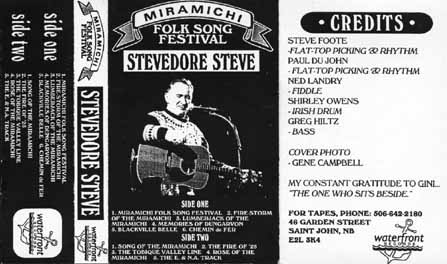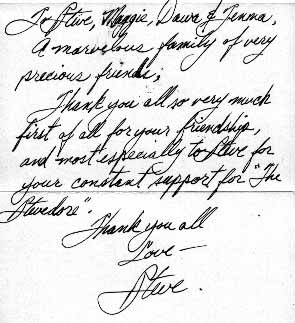
page 10
The Second Coming of Stevedore Steve - part 2

In 1994 Stevedore Steve was asked to perform at the Miramichi Folk Song Festival. First started in the mid-1950s by folklorists Louise Manny and Dr. Helen Creighton as a vehicle to both transmit and celebrate the heritage of the logging era centred in the Miramichi River basin, New Brunswick, the festival has gained international status as a purely traditional, annual event. However, over the past decade or so it has become more and more difficult to extract songs of the logger since many of the men who worked in the bush camps during the heyday of such songs have been dying off. The festival has dealt with this difficult problem by booking artists interested in history even if they compose their own songs. As long as the idiom remains true to the style and heritage, this seems to be an acceptable compromise.
Steve Foote has always been a history buff. Songs about trains and working men have been his forte. Indeed, in his second incarnation as Stevedore Steve he has centred many of his songs on his native New Brunswick. His song, The Iron Horse, tells of one of Canada's first railways which terminated at Moncton Junction. Steve researched the history of the line and discovered that the first rails were made from hardwood since it was too difficult and expensive to import cold-rolled steel rails. With songs like these, Steve was a natural choice to be included in the line-up of that year's festival.
 But
Stevedore Steve was caught off guard! Being of the old school he realized
that if he was going to perform at such a festival then he should have
some product to sell, and why not a cassette of songs about the Miramichi?
He set out to work. writing and recording 11 songs which were quickly put
together a recording session in his kitchen. Using his "Studio-on-a-stick",
laid down some bed-tracks and invited some musicians to participate, including
old Ned Landry on the fiddle. The result was his first album in 18 years,
Miramichi
Folk Song Festival.
But
Stevedore Steve was caught off guard! Being of the old school he realized
that if he was going to perform at such a festival then he should have
some product to sell, and why not a cassette of songs about the Miramichi?
He set out to work. writing and recording 11 songs which were quickly put
together a recording session in his kitchen. Using his "Studio-on-a-stick",
laid down some bed-tracks and invited some musicians to participate, including
old Ned Landry on the fiddle. The result was his first album in 18 years,
Miramichi
Folk Song Festival.
 Playing the Miramichi Folk Song Festival was probably the most therapeutic
thing Steve did to revitalize his career. Besides winning kudos for his
performance there and being treated with the respect that he so deserved
after so many years in the wilderness, the act of putting music out for
sale was the first step in what he hoped would bring him back to the place
he fell from so many years before. When I received my copy of the tape
in the mail it nearly brought a tear or two to my eyes. I realized that
a dream of mine had been achieved, that if Stevedore Steve did nothing
more than this, it was worth every ounce of thought I had given it.
Playing the Miramichi Folk Song Festival was probably the most therapeutic
thing Steve did to revitalize his career. Besides winning kudos for his
performance there and being treated with the respect that he so deserved
after so many years in the wilderness, the act of putting music out for
sale was the first step in what he hoped would bring him back to the place
he fell from so many years before. When I received my copy of the tape
in the mail it nearly brought a tear or two to my eyes. I realized that
a dream of mine had been achieved, that if Stevedore Steve did nothing
more than this, it was worth every ounce of thought I had given it.
In the August 6/7 weekend
edition of the Times-Transcript1:
Newcastle - The 37th annual Miramichi Folksong Festival ended here Friday with a lively concert at the Miramichi Civic Centre, and plans are now under way for next year's event.The songs from this cassette were rich in melody and heritage and are mintage Stevedore. The fact that the theme was exploited to the hilt did not damage the package at all because of the quality of the songs and the performances. To hear the legendary fiddler Ned Landry playing along with the other musicians sitting around the kitchen table added to the ambience that overpowered the poor production qualities.Festival director Susan Butler said many of this year's performers are scheduled to return in 1995, including Stevedore Steve, also known as Steve Foote.
This was Foote's first time at the festival, but he's no stranger to the music business. The Saint John singer/songwriter was a big name back in the 70s when his song Lester The Lobster was a number one hit in Canada.
"That song literally got played all over the world," said Foote in an interview this week. Other hit songs like Minto Miners, Newfie Screech and Giant MacAskill, a ballad about a giant Nova Scotian folk hero from Cape Breton, also earned him recognition.
Foote dropped out of the music business for about 12 years for reasons he won't discuss. "I've been playing on and off for the last four years now and now I'm back at it."
Best known as Stevedore Steve, Foote has four albums and several hit singles. He recently released a Miramichi Folksong Festival tape featuring 11 songs about people and places along the Miramichi River. The songs have been carefully researched and tell tales of life in the region as far back as the great fire of 1825.
"The youth of today don't know their family's history, let alone the history of their community. A song is a great way to teach them."
Foote said his own youthful journeys and a friendship with Stompin' Tom Connors helped form the basis for his music.
"The first time we met we were seven years old. I was in the (Saint John Regional) hospital for appendicitis and I don't know what he was in for." At 15 he and Connors formed a solid friendship as they hitch-hiked across Canada, the United States and Mexico, working as they went.
Foote has since worked as a cowboy, stevedore, truck driver, sailor and trainman. He's also slept in a few boxcars.
"I'm not bragging about being a bum, but that's how we lived for a while - like hobos."
By the time he was 18, Foote had made eight trips across Canada.
"I worked at everything and consequently turned my hand at everything. A lot of it was hard work but I didn't mind. I was young and strong. The romance of the highway and the lure of freedom meant an awful lot to me at that time."
He started performing professionally 28 years ago. "I sang for my supper many times from farmers, but that's not quite the same."
His break came from the Boot Record Company and he decided to make a name change.
"Can you imagine the name of Steve Foote on a Boot label? Stevedore Steve was a firm, fast handle then and it stuck."
As Gerry Taylor put it in his column2:
The tape unfortunately was produced under very austere conditions on Steve's own invention, a "studio on a stick", but does feature Steve's unique songwriting and voice along with the backing of two of New Brunswick's most famous musicians, Ned Landry on fiddle and Paul Du John of Cricklewood on guitar...Having heard a lot of Steve's newer material on basic tapes sent to me since 1989, I was surprised at the elevated quality of this new album. Steve honed the songs and polished them up, packaged them nicely with a meagre budget. He was awarded the Noel Dinn Porcupine award that year for Heritage Preservation.It is the songs, however, that make this tape a must for provincial collectors of our New Brunswick lore. Steve has used his knowledge of the mystique of the Miramichi to create an 11 song suite in its honour. The title song starts it off by paying homage to the yearly event which has so effectively preserved the song, music and dance traditions of this area. Fire Storm of the Miramichi and The Fire of '25 recount natural catastrophes that devastated its verdant forests. Tobique Valley Line, Chemin de Fer and The E & N.A. Track commemorate railroading history and Lumberjack of the Miramichi, Memories of Dungarvon and Song of the Miramichi, its logging heritage. Blackville Belle and Rose of the Miramichi examine the more fanciful side of romantic life on the Miramichi.
As I say, this tape does suffer a little from the economy of its production but the musicianship and songwriting rank it among the most significant tapes I have heard this year.
Sites Gerry Taylor:
Foote Receives Porcupine3
Steve Foote, who has been known professionally for years as Stevedore Steve, is no stranger to awards. He has had many prestigious ones bestowed on him including one for historic achievement by Premier Frank McKenna just this past fall. Now there is another, a 1994 Porcupine Award of Excellence - to be precise, The Noel Dinn Heritage Preservation Award - for a cassette/album titled Songs of the Miramichi (sic) that he produced and released a year ago.Notes
Back to the Index
To The Working Man - the next project,
click HERE
© 1999 & 2010 by
Steve Fruitman for Back To The Sugar Camp ®